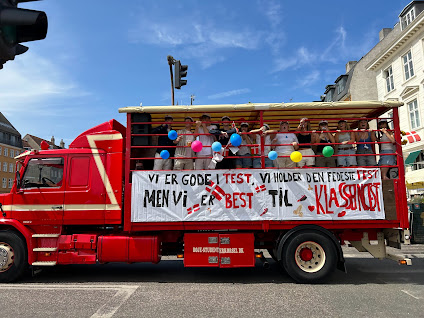The ease with which I adjusted to biking in Copenhagen surprised me. Our initial
assignment of following someone around felt intimidating in a place where I had
never seen so many people biking at once. The person I chose to follow, who was
wearing a long floral green dress that seems incredibly popular here, took me on
a straight line up Øster Voldgade. My first impression of this route was the
ease of travel, despite it being a major car route as well. The lights seem
times so that I rarely had to stop as I biked by impressive museums, old
churches, and brightly colored housing. The ease with which I traveled a
significant amount of distance emphasized how different the bicycle
infrastructure here is from the US. My other initial observations included the
diversity in ages and professions I saw biking. In my first couple of days, I’ve
seen young children, students, the elderly, and everything in between biking all
over the city. I’ve also seen people biking in casual summer clothing,
professional work outfits, formal wear, and even clothes that look like they
belong in a dance club. I think this emphasizes how incorporated biking is into
the culture here, that people of all facets of life bike regularly.
 |
| Angie at Nyllhaven |
I am amazed by the Danish use of the Third Place. Almost everywhere we go people
are socializing, laughing, or simply existing, making it seem like the entire
country is the Third Place, a concept elusive in American Society. People's
access to safe, welcoming, and vibrant spaces outside of their homes and
work/school creates a vibrant and interconnected society. Bike Mike mentioned
trust as a significant part of Danish culture and I think this access to a Third
Place is a huge part of creating that societal trust.
 |
| Full Immersion into Danish Culture |
This leads me to another
impression I had one of our free days. Several others in the group and I chose
to bike to La Banchina to go swimming. The sheer amount of people there
surprised me, I believe Bike Mike said it best, “all Danes yearn for the sea!”.
The amount of leisure and public activities people take place in has been very
eye-opening to the differences between Danish and American culture. In general,
I think Americans work more and have less free time and less space to engage in
leisurely activities. This is evident in the partying, long lunches, and other
fun aspects of Denmark I have seen so far. I believe that this is beneficial to
their physical and mental health, in addition to the regular cardio they get
from biking.
 |
| Recent Danish Graduates |
My biggest takeaway these first couple of days has been how biking is
so incorporated into daily life and culture. People can bike long or short
distances to basically anywhere in the city, and do any activity when they
arrive. I see children biking with their friends alone, teenagers biking and
obeying traffic laws, and older couples taking bike rides through quieter
streets. It interconnects the city in a way car traffic does not. The themes of
my impressions all seem to fall under the interconnectedness, both physically
and metaphorically, in Danish society. Bicycles play a huge role in the physical
interconnectedness of Copenhagen, but also the metaphorical.



Very interesting to read about your first impressions, including how quickly one of your key questions was answered - the age and diversity of people biking.
ReplyDelete